Overview
- Brief Narrative
- Imperial Germany Darlehnskassenschein [State Loan Office] emergency 1 [eine] mark note from the album of Hauptsturmfuhrer Gerhard Pleiss, a officer in the Waffen-SS, SS-Panzer-Division Leibstandarte SS "Adolf Hitler," 1st Company. Notes of this type were first issued as supplemental currency at the beginning of World War I (1914-1918) and remained in circulation until the hyperinflation of 1923. In 1936, the 21 year old Pleiss volunteered for the SS and was accepted into the Leibstandart, Hitler's personal bodyguard. He was awarded for his leadership in the May 1940 invasion of France and the April 1941 Balkans campaign. In June 1941, Germany invaded the Soviet Union. Pleiss was killed by a mine on November 17, 1941, during the offensive on Rostov-on-Don. The note was preserved in Pleiss's photograph album, which was brought back from the war by Milton V. Elliott, an American soldier.
- Date
-
issue:
approximately 1920 March
- Geography
-
issue:
Berlin (Germany)
- Credit Line
- United States Holocaust Memorial Museum Collection, Gift of Wendie Theus
- Markings
- face, top, red ink : 435 · 034874
face, top, black ink : Darlehnskassenschein / Eine Mark
face, center, white on brown field : 1 / mark
face, bottom, brown ink : 1 mark / Berlin den 1 Marz 1920 / ReichsSchuldenverwaltung / signatures /
back, green ink : 1 mark / Darlehnskassenschein / 1 mark / Eine Mark - Contributor
-
Original owner:
Gerhard Pleiss
Subject: Gerhard Pleiss
Issuer: Darlehnskassenschein
Subject: Milton V. Elliott
- Biography
-
Gerhard (Gerd) Pleiss was born on April 20, 1915, in Remscheid, Germany. He attended gymnasium in Dortmund and then began an apprenticeship with a dentist. He volunteered for the SS in April 1936 and was accepted into the Leibstandarte SS Adolf Hitler, 1st SS Company. This unit was Hitler's personal bodyguard, charged with guarding Hitler, his office, and personal residences. Pleiss attended SS-Junker school in Braunschweig and, in April 1939, was promoted to Untersturmfuhrer. He participated in the invasion of France in May 1940 and was awarded the Iron Cross, 1st class. In 1941, the Leibstandarte became part of the Waffen SS, during preparations for Operation Barbarossa, the planned invasion of the Soviet Union. SS-Hauptsturmführer Pleiss was made commander, 1st Company LSSAH, for the campaign in the Balkans. In April 1941, during the Battle of Vevi in northern Greece, Pleiss's unit captured Klidi Pass from British troops, opening the way into Greece. He was wounded, but remained in command. Pleiss was awarded the Knight's Cross, the highest award for bravery and leadership, which was personally presented to him by Hitler on April 21 in Berlin. Operation Barbarossa was launched on June 22, 1941. Pleiss was mortally wounded on November 17, 1941, when he stepped on a land mine during the attack on Rostov-on-Don (Rostov-na-Donu, Russia.)
Milton Verne Elliott was born on May 25, 1921, in Thayer, Kansas, to Vern H. and Ann C. Glentzer Elliott. He had a sister Ernestine. In August 1940, Milton enlisted in the United States Army. America entered World War II in December 1941. At some point, Milton was deployed to the European Theater of Operations. He returned to the US after the war ended in May 1945. In 1948, Milton married Gladys Baldwin. The couple had one daughter. Milton, 82, died in October 2003 in Missouri.
Physical Details
- Language
- German
- Classification
-
Exchange Media
- Category
-
Money
- Object Type
-
Emergency currency (lcsh)
- Physical Description
- Small rectangular currency on watermarked paper with a face in black, green, and brown ink on a yellow latticework background. Across the center is a rectangular ornament with the denomination 1 Mark in the center and bottom corners. At the top is the serial number in red ink and Eine Mark. On the left center is a red Imperial seal and on the right is a white embossed seal. The back has black, green, and brown ink on a yellow latticework background with 1 MARK repeated in alternating lattice triangles. The denomination 1 Mark is in the top corners. In the center is an intricate ornament with the denomination 1 repeated 3 times and Eine Mark at the bottom. It has a central crease, worn edges, and some discoloration.
- Dimensions
- overall: Height: 2.375 inches (6.033 cm) | Width: 3.500 inches (8.89 cm)
- Materials
- overall : paper, ink
Rights & Restrictions
- Conditions on Access
- No restrictions on access
- Conditions on Use
- No restrictions on use
Keywords & Subjects
Administrative Notes
- Legal Status
- Permanent Collection
- Provenance
- The bank note was donated to the United States Holocaust Memorial Museum in 2013 by Wendie Theus, the daughter of Milton V. Elliott.
- Funding Note
- The cataloging of this artifact has been supported by a grant from the Conference on Jewish Material Claims Against Germany.
- Record last modified:
- 2023-08-28 08:08:21
- This page:
- https://collections.ushmm.org/search/catalog/irn85297
Download & Licensing
In-Person Research
- By Appointment
- Request 21 Days in Advance of Visit
- Plan a Research Visit
- Request to See This Object
Contact Us
Also in Milton V. Elliot / Gerhard Pleiss collection
The collection consists of five German bank notes and a photograph album relating to the experiences of Gerhard Pleiss, an officer in the Leibstandart SS Adolf Hitler, 1st Company, in Nazi Germany, as well as the experiences of Milton Verne Elliott, a soldier in the United States Army who discovered the album during World War II.
Date: 1910-1942
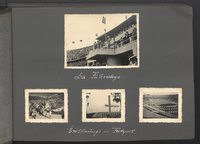
Gerd Pleiss photograph album
Document
Consists of a photograph album consisting of photographs of military training, Nazi rallies, the 1936 Berlin Olympics, and Berchtesgaden, all 1936-1937. The album was compiled by Gerd Pleiss, a member of the Leibstandart SS Adolf Hitler, 1st Company, and includes amateur photographs of leading Nazi personalities.
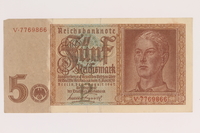
Nazi Germany, 5 mark note from the album of a Waffen-SS officer acquired by an American soldier
Object
Nazi Germany, 5 [funf] mark note from the album of Hauptsturmfuhrer Gerhard Pleiss, an officer in the Waffen-SS, SS-Panzer-Division Leibstandarte SS "Adolf Hitler," 1st Company. Notes of this type were first issued as supplemental currency at the beginning of World War I (1914-1918) and remained in circulation until the hyperinflation of 1923. In 1936, the 21 year old Pleiss volunteered for the SS and was accepted into the Leibstandart, Hitler's personal bodyguard. He was awarded for his leadership in the May 1940 invasion of France and the April 1941 Balkans campaign. In June 1941, Germany invaded the Soviet Union. Pleiss was killed by a mine on November 17, 1941, during the offensive on Rostov-on-Don. The note was preserved in Pleiss's photograph album, which was brought back from the war by Milton V. Elliott, an American soldier.
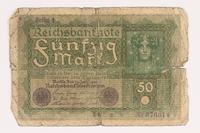
Imperial Germany, 50 mark note, series 1, from the album of a Waffen-SS officer acquired by an American soldier
Object
Imperial Germany 50 [funfzig] mark note from the album of Hauptsturmfuhrer Gerhard Pleiss, an officer in the Waffen-SS, SS-Panzer-Division Leibstandarte SS "Adolf Hitler," 1st Company. This note, issued in June 1919, bears the Imperial eagle crest and was the final issue of Imperial Germany, although that regime collapsed in November 1918, at the end of World War I. Germany then became a republic, but was in a transitional period until the new constitution was adopted in Weimar in August 1919. In 1936, the 21 year old Pleiss volunteered for the SS and was accepted into the Leibstandart, Hitler's personal bodyguard. He was awarded for his leadership in the May 1940 invasion of France and the April 1941 Balkans campaign. In June 1941, Germany invaded the Soviet Union. Pleiss was killed by a mine on November 17, 1941, during the offensive on Rostov-on-Don. The note was preserved in Pleiss's photograph album, which was brought back from the war by Milton V. Elliott, an American soldier.
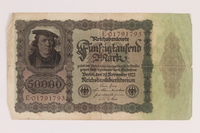
Weimar Germany, 50000 mark note, from the album of a Waffen-SS officer acquired by an American soldier
Object
Weimar Germany emergency 50,000 [funfzig tausend] mark note from the album of Hauptsturmfuhrer Gerhard Pleiss, an officer in the Waffen-SS, SS-Panzer-Division Leibstandarte SS "Adolf Hitler," 1st Company. Notes of this type were issued in 1922 as emergency currency during the years of hyperinflation. In 1936, the 21 year old Pleiss volunteered for the SS and was accepted into the Leibstandart, Hitler's personal bodyguard. He was awarded for his leadership in the May 1940 invasion of France and the April 1941 Balkans campaign. In June 1941, Germany invaded the Soviet Union. Pleiss was killed by a mine on November 17, 1941, during the offensive on Rostov-on-Don. The note was preserved in Pleiss's photograph album, which was brought back from the war by Milton V. Elliott, an American soldier.
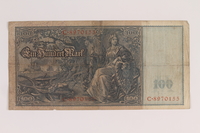
Imperial Germany Reichsbanknote, 100 mark note, from the album of a Waffen-SS officer acquired by an American soldier
Object
Imperial Germany Reichsbanknote, 100 [ein hundert] mark note from the album of Hauptsturmfuhrer Gerhard Pleiss, an officer in the Waffen-SS, SS-Panzer-Division Leibstandarte SS "Adolf Hitler," 1st Company. This type of note was first issued on February 8, 1908, during the reign of Kaiser Wilhelm II. In 1936, the 21 year old Pleiss volunteered for the SS and was accepted into the Leibstandart, Hitler's personal bodyguard. He was awarded for his leadership in the May 1940 invasion of France and the April 1941 Balkans campaign. In June 1941, Germany invaded the Soviet Union. Pleiss was killed by a mine on November 17, 1941, during the offensive on Rostov-on-Don. The note was preserved in Pleiss's photograph album, which was brought back from the war by Milton V. Elliott, an American soldier.



